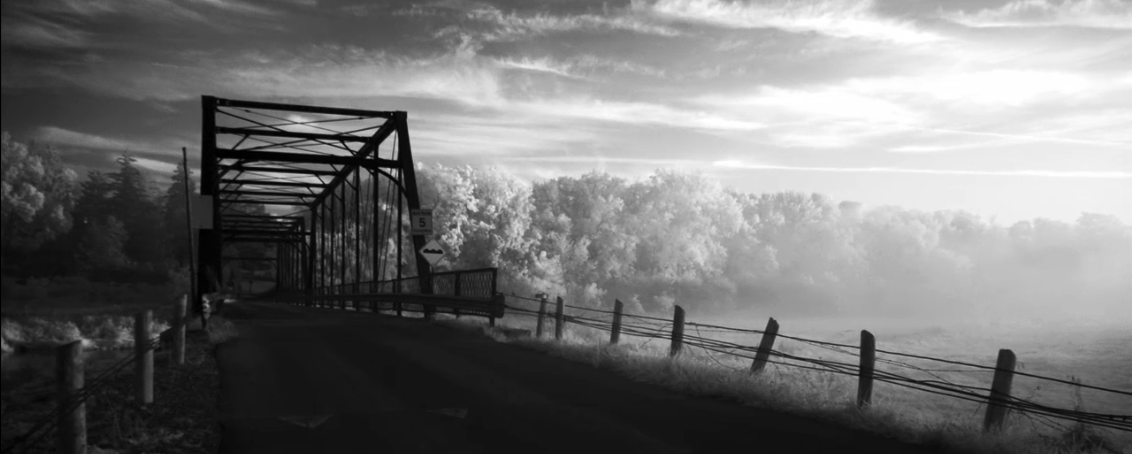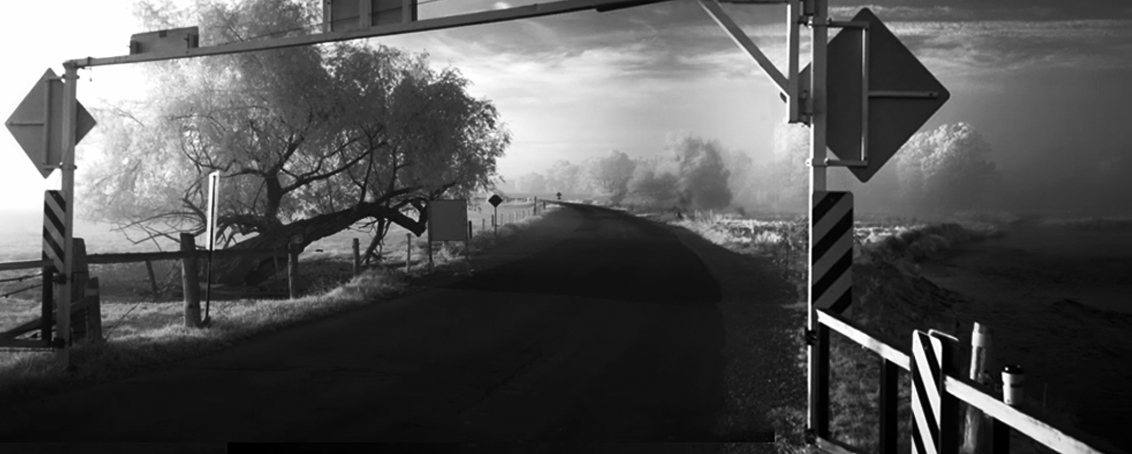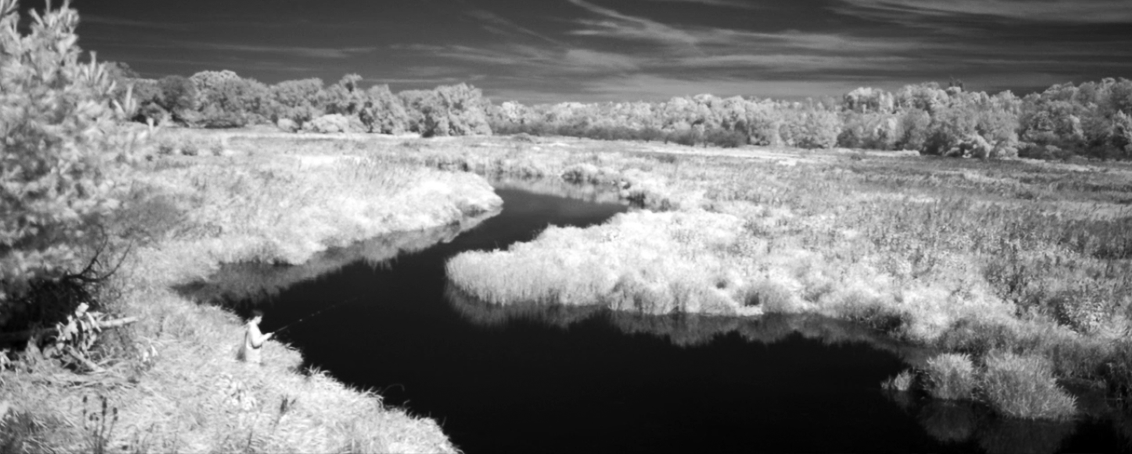Art > Heaven on Earth > White Paper
Heaven on Earth is an ambient multimedia projection and a visual meditation celebrating our connections to the world around us. The following research paper outlines the technical and aesthetic considerations addressed in relation to the creation of this artwork, and situates it within the broader context of environmental and documentary film-making.
Introduction
This paper explores issues related to the defining of an aesthetic vision within the context of environmentalism, and how the production of a media artwork and a corresponding reflection on its creative process addresses several of them. The work began as a graduate project in the Faculty of Environment at the University of Waterloo in late 2017. To provide an entry point, we’ll begin by re-capping the original project brief submitted as a proposal for this course, and offer up any reframing of its scope in order to accommodate insights derived during the creation of its initial prototype, its corresponding written reflections, and an associated brief literature review.
Following the original project brief, which paid attention to outlining the project broadly, the resulting prototype media artwork comprises several aspects; a slowly rotating panorama of landscapes that have been recorded in black and white digital infrared video, overlaying typeset text passages from the twelfth century poet Rumi, and a soundtrack consisting of several pieces of audio.
More particularly, these infrared digital video recordings of landscapes initially made around Waterloo Region aim to evoke sensations of eerily-entrancing otherworldliness. The effect of the glowing white vegetation caused by the infrared’s chlorophyll effect contrasts with dark waters and background skies to create a visual tableau that is all at once familiar, while also appearing somewhat strange, as though viewed through the eyes of a different being. Overlapping the striking infrared landscape imagery are poems and excerpts of translated work by the Sufi poet that celebrate mystical love, and become tributes to the divine, ever-present other as manifest in nature and our surrounding physical environment. The background music; a blend of ambient textures from Canadian composer and musician Lee Rosevere together with field recorded sound, serves to both compliment and contrast with the visual and textual imagery. The passages of poetry and the feelings they evoke become contrasted with the familiar-yet-unfamiliar black and white infrared landscapes, and invite the viewer to reconsider the otherwise mundane and taken-for-granted physical environment around us from an alternative, surreal vantage point.
The artwork will draw loosely on influences of photographer-film-makers Edward Burtynsky and Peter Mettler, who through their films “Watermark” (2013), and “Petropolis” (2009), respectively, capture serene but often changed and sometimes diminished landscapes in both their natural and human-touched splendor.
The narrative is essentially visual; a meditation on nature that stands on its own, and where the addition of textual components help direct the viewer’s imagination along an intentional but loosely-defined path. A path that invites them to appreciate anew the natural and built landscapes, and turn their portrayal through this media into heaven-like vistas, whose beauty becomes imbued with new meaning via the inclusion of verses of Sufi poetry, and an ethereal background soundtrack.
Technical Considerations
When embarking on a project that could grow and become a complex undertaking, it’s worthwhile to conduct lo-fidelity experiments in an effort to ensure that the whole thing can be carried out successfully. In this instance, two initial challenges were; achieving the ability to record infrared video, and then to record it with a continuous smooth 360 degree panning motion.
An infrared lens filter was purchased. Several options were explored to enable the smooth motion panning of the camera, including a review of programmable Lego motors as a possibility. A separate trip was made to an electronics store to look at the option of building a set-up using a stepper motor and an Arduino controller. Eventually it was revealed that these sorts of gadgets, built primarily for this and photo time-lapse applications, could be purchased. The video results and hardware specifications of several gadgets were reviewed online; ascertaining which could best turn at a sufficient variety of speeds, and support the significant weight of the video camera without compromising the accuracy or integrity of the resulting panorama’s smoothness. One particular motor was chosen and purchased. Then, the videocamera and a shotgun mic were borrowed to complete the kit.
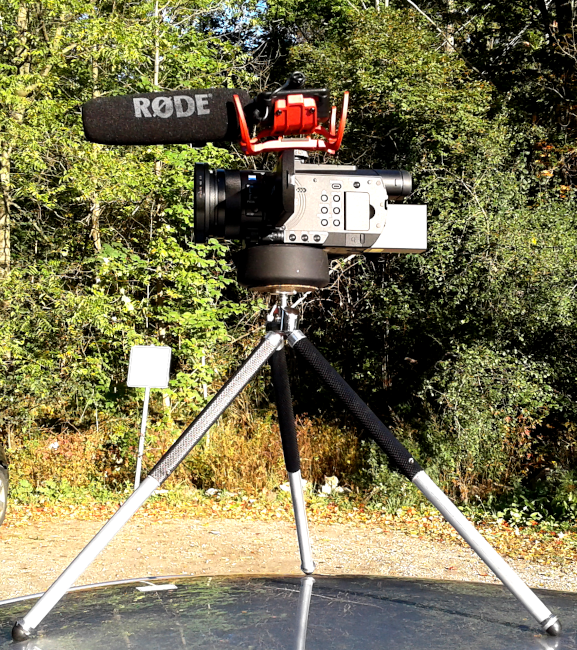
Complications arose when it was determined that in order to enable the camera’s infrared feature, it needed to be switched to 'automatic' mode. Unfortunately, this resulted in the inability to make any manual exposure adjustments, which lead to making recording outdoors nearly impossible whilst sunny unless it was close to sunrise or sunset. This recalled the shooting of many rolls of black and white high-speed infrared film to create still images during the 1990s, when there was considerable guesswork as photos were captured on a non-SLR 35mm camera without any meaningful preview other than the tiny range-finding eyepiece through which the shot could be roughly composed. Pointing the camera perpendicular to the direction of the sun also seemed to best highlight the infrared features of the landscape. This, though, would need to be put aside when considering making full circle panoramas, where instances of even having the camera point directly into the sun for several moments, albeit with a very dark red filter, would be virtually unavoidable.
Soundtrack issues were relatively easy to deal with. Generous support from the Free Music Archive over the years was instrumental in this regard. Numerous ambient and experiemntal artists and soundscapes from their vast site had been previewed and then played over the radio from Guelph, Ontario, each week on CFRU FM as part of the author's own programme, which provided valuable insight into this wonderful media storehouse. Musical artists often post their material here expressly for these sorts of applications; to be used as part of other art and media projects, and often for just a credit mention. In this case, music by Canadian composer Lee Rosevere lent itself particularly well to the theme that was being established with the footage and poetry of the "Heaven on Earth" piece.
After surmounting several more minor technical challenges that arose during its production, mainly surrounding the obtaining of a correct exposure, the video recorded infrared imagery did live up to aspirations of a dream-like portrayal of several panoramic vistas around the region of Waterloo. (Several stills from the footage appear in this paper). In addition to the video recording itself, a shotgun microphone was mounted on the camera, and field recordings were made of the particular areas’ natural ambient sounds. These sounds were then included as a track, along with Lee Rosevere's ambient music, within the finished piece. The video is an hour in length, revealing multiple panoramas that flow from one to the next, and the entire piece is intended to be looped over and over again, indefinitely.
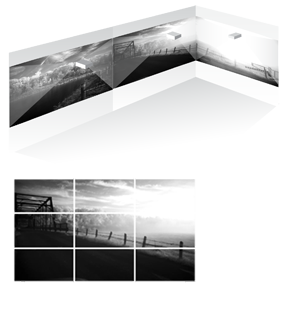
Apart from the production, a process was begun to explore what would be technically required to ultimately display the artwork on several adjacent screens in such a way as to have the panorama spill onto an adjoining screen or screens, and create an extra-wide, slowly-moving panorama that gave the illusion of a continuous long, wide pan. Although just a few minor hurdles could be foreseen in preparing the footage for a video tile wall format, the alternate and perhaps preferred means of projection; using multiple projectors and surfaces in this rotating panorama manner; carried alot more uncertainty from the standpoint of technical feasibility. To test at this early stage would set that part of the project in motion and help to identify most, if not all, of the potential technical barriers early on.

Aesthetic Vision
A brief literature review was conducted in an effort to provide some contextual framing of the media artwork, delving into several articles on aesthetics and environmental aesthetics, coupled with some assessments of other pieces of environmentally-oriented media and art that were begun some time ago. Several threads including aesthetics, environmentalism, and spirituality were brought together to help illuminate the rationale behind the piece’s creative process and production, and to situate it in a particular context.
In order to ground the discussion, some definition of aesthetics in the context of the media artwork needs to be outlined. Berleant’s (2010) non-cognitive approaches to the aesthetic appreciation of the natural environment involve defining aesthetics broadly, and despite his view that humans, culture, the built environment, as well as the natural environment, should be included within such an aesthetic definition of the environment, the media-art in question does aim, through its definition as art, to inspire a more whole appreciation of the environment. This would be as opposed to the environment instead inspiring the creation of art in order to arrive at a fuller appreciation of it. Further, “within the sublime is an awe and humility which he (Berleant) sees as an appropriate basis for an aesthetics of nature which exceeds the human mind”, and that “ultimately, such an awareness of nature puts the audience in a position of wonder, humility, awe, reciprocity, and vulnerability” (Clark, 2010, p. 358). This perspective can therefore serve to bring environmental aesthetics to the fore in order for us to better appreciate the social, cultural, and built environments we inhabit. From this it could be postulated that a more comprehensive and engaged environmental aesthetic has the ability to foster a more respectful relationship with our natural environment.
To further clarify the scope of the proposed media artwork, it becomes important to raise the notion that many of the films and media produced by environmental advocacy organizations such as the Cousteau Society, the Wilderness Society, the National Wildlife Federation, and Greenpeace, to name a few, follow Grierson’s model where natural imagery and footage are really about humanity’s relationship to nature and our impact, often adverse, upon it. Also falling within the scope of such documentaries are all of the interrelated political, economic, and social aspects tied to environmental policy reform, resource conservation, and the advocating for sustainable societies which encourage humanity to operate in harmony with nature (Bouse, 1998).
While many works in this so-called activist genre can have a tendency to leave the viewer feeling distressed by the magnitude of humanity’s impact on nature, likely in some effort to prompt action, such as the film “Petropolis” (2009) by Peter Mettler, the "Heaven on Earth" artwork aims to have essentially the opposite effect and looks instead to leaving the viewer feeling hopeful and inspired by nature’s beauty and the potential of our relationship to it, and that despite our various impacts, we are nonetheless its offspring and must celebrate its gifts of beauty for their oft-neglected preciousness.
Viewers of the installed artwork will be encouraged to reflect on the notion of reality itself as a construct, and that our narrow visible spectrum perception only provides one view into the world of matter and energy. “The often invisible lines in film between documentary, entertainment, education, and even art have continued to be a source of vexation for critics and scholars over the years” (Bouse, 1998, p. 123). Moreover, despite Clark’s (2010) assertion that aesthetic debates within contemporary art have been somewhat tangential to the debates in environmental aesthetics since the 1960’s, the aim of the “Heaven on Earth” media artwork is to upend this paradigm and make the purely artistic aesthetic elements the “spine” from which the aesthetically environmental and spiritual aspects might sprout. As previously alluded to, a substantial portion of the current taxonomy of environmental filmmaking and media production can be said to be polarizing; often positioning humanity as a thoughtless, wasteful intruder upon the landscape, thus taking an activist stance. The piece in question aims rather to be a celebration of nature more for its own sake in terms of both the natural and built environments. The overlaying verses of poetry intend to further underscore a sublime beauty which has all too often receded into the background of humanity’s present day consumer and technology-driven lives.
Removing overtly conservationist justifications from the equation can, however, still leave the artwork open to an ecological potential. As Clark mentions, even the passive enjoyment of scenery can have environmental implications through enabling a deeper, more active aesthetic appreciation of nature which in turn fosters a “more respectful, less instrumental, or at least less thoughtlessly destructive relationship with the natural environment” (Clark, 2010, p. 354).
According to Sparshott, a photographic, or in our case a cinematographic image’s aim is generally not towards reproducing human vision in the technical sense, but rather to achieve a dream of an ideal vision. Despite photography or film’s ability to create an undisputable sense of authenticity, Sparshott’s claim that “looking at a good photograph is not like looking at the photographed thing, but rather a faithful record” (Sparshott, 1971, p. 15), warrants scrutiny insofar as under normal circumstances the illusion created through imagery is not reality, but a sort of “unattributable vivacity”.
It is this unattributable vivacity that is deliberately sought out in this project’s artwork, and particular efforts are made so as to achieve its realization using a medium that has become quite saturated in its recent employ via the democratizing of technology. In our case, efforts at achieving its realization are accomplished by using techniques so as to resist conventional strictures and deliberately call attention to the subject matter by portraying it in an unconventional manner, namely the slowly-rotating black and white infrared panoramas, the Sufi poetry and the ambient soundtrack. Against an urge to have the medium manifest an honest reliance on its capacity to portray authenticity and preserve reality in order to convey a technically-accurate chronicle, the efforts here endeavour instead to use the medium to present surreal appearances, despite their being rooted in more conventional definitions of reality.
This difference forces any standard description of perception, or of reality, to expand to include, for example, portions of the electromagnetic spectrum that are not normally visible to the naked eye. The strange, winter-bleached panoramas can also induce reflection about the fragility and impermanence of our physical existence, in all its manifest instantiations including physical structures, and at points perhaps resemble the themes on display in Robert Fantinatto’s film “Echoes of Forgotten Places” (2005); lush with footage of abandoned factories that have somehow been rendered mystically beautiful in their stillness and decrepetiude. This visual imparting of the undescribable helps to connect the viewer with the subject matter, in our case; the otherwise banal rural landscapes.
Similar to how the photographer and artist Andy Goldsworthy, through his site-specific work such as that presented in the book “A Collaboration with Nature” (1990), rearranges natural objects in their various contexts to expose new facets of their beauty, this work aims for a similar effect: A revealing of hidden beauty, not so much by overt placement or arrangement of objects within the frame, but via both science, through making the infrared spectrum visible; and art, through the words of the poet Rumi and the background rumble of ambient soundscapes. These characteristically human studies now become useful instruments to illuminate the importance of our connection to the environment around us. Human-defining analytical and creative traits afforded by both science and art find significant application in eloquently illustrating our intrinsic bonds with the environment. An atypical cinematographic language is thus constructed which is apprehendable and accessible to an audience who may otherwise have their own definition of what aesthetically-pleasing cinema is. “Film is necessarily an art of illusion from the very beginning; and illusion, like technology, serves as a focal point around which aesthetic disputes arrange themselves” (Sparshott, 1971, p. 12).
An Environmental Spirituality
As Bannon (2011) suggests, art, and by extension film and media art, can “provide alternate ways of envisioning the human relationship to nature and thereby present an alternate mode of dwelling within it” (p. 415). More particularly, a non-dualistic vision of nature and a similarly non-dualistic relationship to it can be attained that successfully links aesthetic and ecological values. Carlson’s reductionist view of the appreciation of nature provides a template as to how a landscape should look, and hence creates certain aesthetic expectations which now become disrupted in this artwork’s presentation. It thus defies conventional categorization as documentary or natural landscape film or artwork, and attempts instead to situate itself in the artistically aesthetic realms of the numinous. The aesthetic appreciation of nature becomes somewhat of a need that is not based in science, and thus responds in part to Rolston’s call for a “science-transcending aesthetic of participatory experience” (Bannon, 2011, p. 422).
These thoroughly written-about philosophical issues in aesthetics and environmentalism can now perhaps point towards helping complete the puzzle of an even broader perspective of environmentalism that embodies a spiritual connection between ourselves and our environment. The installed artwork invites the viewer to hold these dream-like vistas in attention and not only consider the natural beauty of the scenery, but perhaps also enable a deeper reflection on our relationships to one another and to our surroundings. David Bohm, a theoretical physicist and contemporary of Einstein thought at one point to be his successor but who became disillusioned and was ultimately exiled following his work on the Manhattan project, described our view of reality as a quantum-mechanically unfolded slice of a larger, invisible, implicate order (Bohm & Peat,1987). An order where every atom and everything are connected on some level; including people to each other, as well as to our various environments, including their flora and fauna. Our conditioned patterns of thought have, however, rendered these connections invisible; not only to science and the capabilities of the scientific method, but invisible to a deeper, felt sense within each of us. A connection whose roots have perhaps become eroded in part due to our industrial and information age evolutionary trajectories. Rolston states that although science should attempt to demythologize culturally-held perspectives on nature, it should nonetheless find a new myth that “encourages appropriate aesthetic responses to nature, responses that will sometimes be of the sublime and the numinous” (Rolston, 1995,p. 384). This is further underscored by Bannon’s suggestion that “while scientific knowledge can enrich our experience, there is something more to our appreciation of nature than merely our cognitive evaluations of the landscape” (Bannon, 2011, p. 423).
Perhaps a similar vernacular to encompass a deeper connection to nature already exists in indigenous spirituality and art. Native cultures have accessed and defined these sorts of connections which have formed the basis for their religious beliefs, for many centuries. Moreover, such nature-bound traditions can help to inform, or provide an underlying common denominator for the world’s other religious traditions, and serve to unite humanity on some foundational level by encouraging a celebration of our connection to the natural environment, and a sharing of its beauty. This could in turn inform conservationist and natural aesthetic philosophies, and foster a fuller, holier appreciation of nature, beyond activist or physical resource-focused perspectives.
Conclusion
This paper provides an outline for the potential of an emerging narrative in the broader context of aesthetics, environmentalism, and spirituality, through the corresponding development of a media artwork which is installed publically through a multiple projection or a multiple screen display system. The author’s efforts as an artist throughout this project have sought to echo Bannon’s sentiments that, “Artists are in the business of providing communities with new metaphors that challenge and hence broaden our comprehension of the world... and help inform our perception in different ways” (Bannon, 2011, p. 424).
References
Bannon, B. E. (2011). Re-envisioning nature: The role of aesthetics in environmental ethics. Environmental Ethics, 33(4), 415-436. doi:10.5840/enviroethics201133445
Berleant, A. (2010). Reconsidering scenic beauty. Environmental Values, 19, 335-350. doi:10.3197/096327110X519862
Bohm, D., & Peat, D. (1987). Science, Order and Creativity. New York: Bantam.
Bouse, D. (1998). Are wildlife films really "nature documentaries"? Critical Studies in Mass Communication, 15, 116-140. doi:10.1080/15295039809367038
Clark, S. (2010). Contemporary art and environmental ethics. Environmental Values, 19(3), 351-371.
DePencier, N. (Producer), Burtynsky, E., & Baichwal, J. (Directors). (2013). Watermark [Motion Picture]. Canada: Mongrel Media.
Fantinatto, R., Beales, L. (Producers), & Fantinatto, R. (Director). (2005). Echoes of Forgotten Places [Motion Picture]. Canada: Scribble Media.
Flahive, G., Hofer, B., Seitler, C., Veninger, I. (Producers), & Mettler, P. (Director). (2012). The End of Time [Motion Picture]. Canada: First Run Features (U.S.).
Goldsworthy, A. (1990). A Collaboration with Nature. New York, United States: Harry N. Abrams.
Kolin, A. M., & Mafi, M. (2009). Rumi’s Little Book of Love. Charlottesville, United States: Hampton Roads.
Rolston, H. (1995). Does aesthetic appreciation of nature need to be science based? British Journal of Aesthetics, 35, 164-172. doi:10.1093/bjaesthetics/35.4.374
Rolston, H. (2008). From beauty to duty: Aesthetics of nature and environmental ethics. In A. Carlson, & S. Lintott, Nature, Aesthetics, and Environmentalism: From Beauty to Duty (pp. 325-337). New York: Columbia University Press.
Severiac, L., Hunter, S. (Producers), & Mettler, P. (Director). (2009). Petropolis: Aerial Perspectives on the Alberta Tar Sands [Motion Picture]. Canada: Mongrel Media.
Sparshott, F. E. (1971). Basic Film Aesthetics. The Journal of Aesthetic Education, 5(2), 11-34.
